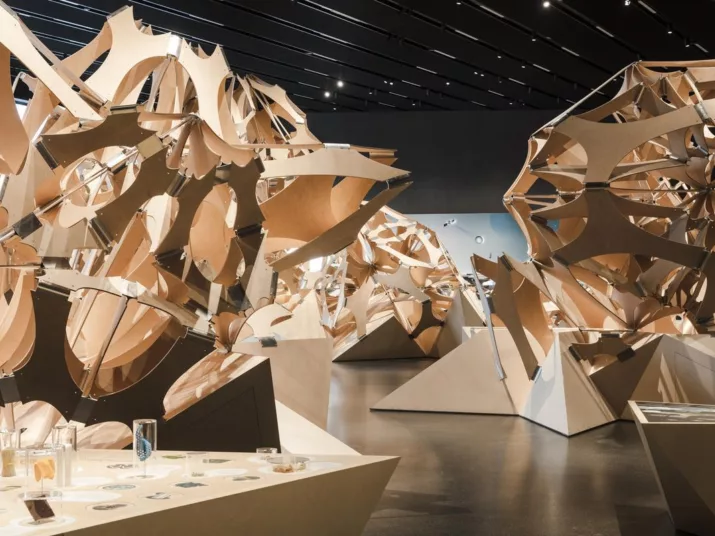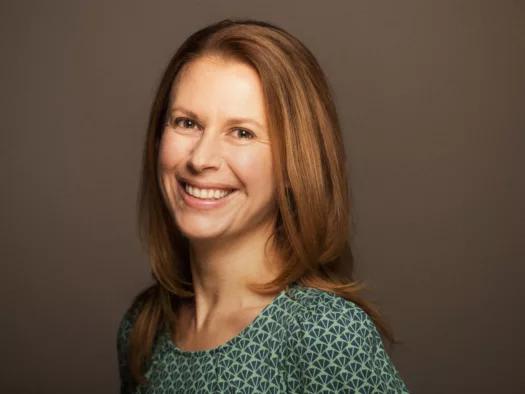
Photo: David von Becker
Thinking Space Nature
Bio-based Future at Futurium
Exhibition organisers Rosalina Babourkova and Jasmin Minges tell us about those parts of the Futurium exhibition that focus on bioeconomy and biobased innovations – and which of the exhibits are their personal favourites. The complete interview by Kristin Kambach was first published at biooekonomie.de.

Photo: David von Becker
The topic of bioeconomy takes up a lot of space at Futurium. Which exhibits point the way towards a bio-based future?
Jasmin Minges: There are, for example, many exciting exhibits that show how in the future we might come to live in a world without waste. Visitors can discover new materials produced from renewable raw materials that are already fully biodegradable or are likely to become so in the future. Flip-flops made of algae, for example, and compostable lamps or biodegradable plastics made from orange peel. But visitors can also get a glimpse of an ideal closed-loop factory and see how the manufacturing processes there can be organised in ways that generate less industrial waste.
Rosalina Babourkova: Building materials could also become renewable in the future. One of our exhibits is the prototype of a load-bearing structure whose building elements have been grown from mycelium – that is, the roots of fungi – and plant debris. Smaller bamboo elements in between these materials reinforce the structure. Bamboo grows very quickly, binds a lot of CO₂ and is found in many parts of the world. As a building material, bamboo combines strength and flexibility. Researchers are currently testing how bamboo could replace steel as a reinforcing material in concrete.
Rosalina Babourkova is a research associate in the exhibition team. She has a PhD in urban studies and has studied geography and environmental management.

Photo: Ali Ghandtschi
Which ideas do you want to convey in this part of the exhibition?
Minges: In one part of the exhibition we ask how we can think about nature in new ways. At this point in time, we’re causing massive damage to the environment and climate. And one thing’s for sure: humans are going to continue interfering with the environment. But how can we manage to satisfy our needs without destroying nature even further? What we’re doing in this exhibition is to present examples of how we can come to new and more sustainable solutions, while conserving nature and exploring it further.
Babourkova: And there’s yet another important message, namely, that there are already lots of different solutions available. Researchers, designers and entrepreneurs are working on ways to conserve resources and reduce the mountains of waste. But there are still hurdles to overcome. For example, we need to think hard about which renewable raw materials we should use – and which of them need a lot of arable land that we could better use for food production; another question would be whether we still need such large quantities of packaging material.
Which bio-based object is your personal favourite in the exhibition, and why?
Babourkova: My favourite exhibit is once again to do with the subject of building. There’s an exciting model of a building: a prototype of a flat that’s currently the subject of research – the Urban Mining and Recycling (UMAR) Experimental Unit. The flat prototype is a joint project by Werner Sobek, Dirk Hebel and Felix Heisel, and it’s located in the NEST research building on the campus of the Swiss Federal Laboratories for Materials Science and Technology (Empa) in Switzerland. For our model at Futurium, we’ve taken it apart to show the different layers of material. For example, there’s an insulating layer made from jeans or drink cartons. The UMAR is a wonderful example of how building materials from old buildings and utilitarian objects can be incorporated into new construction. In addition, all the components of the flat are interconnected in such a way that they can be entirely recovered and separated out cleanly, and then reused or recycled. Based on this principle, even complex products such as entire houses can be designed in such a way that their materials are capable of being introduced back into their respective materials cycles.
Jasmin Minges is a research associate in the exhibition team. She studied European ethnology, modern and contemporary history, and culture, communication & management.

Photo: Ali Ghandtschi
Minges: The large sculpture in the Thinking Space Nature. In contrast to the UMAR flat prototype, it’s an abstract piece of art. It gives me a sense of how exciting it can be to let yourself be inspired by the shapes of nature. And it invites you to dream about what our environment might look like in the future. From a technological perspective, the planning and construction of the art installation were highly complex. The shape was calculated by an algorithm so that a fascinating shape emerged from only eleven different types of wooden components. The craftspeople used augmented-reality glasses to insert each of the more than 13,000 parts in the right place.
What would a bio-based and sustainable future look like for you personally?
Babourkova: Everything I consume in everyday life – the clothes I wear, the cosmetics I use – would be made from biodegradable materials. Packaging would be reduced to the bare minimum. And if a product really does need packaging, then the latter would be biodegradable too. Household appliances would be designed in a way that allows them to be easily disassembled into their components after use. And the individual materials would return to their production cycles. The entire industry would be logistically organised in such a way that users can easily send back more complex products to the manufacturers, who then take them apart and recycle them. Different manufacturers and industries would be networked in their production processes. In this way, manufacturers could provide each other quickly and easily with recycled raw materials, and exchange the latter, while valuable raw materials such as metals or sand would no longer have to be obtained directly from nature.
Minges: As many items as possible would be produced sustainably and fairly. However, I also think there’s no getting around the need to reconsider and reduce our consumption. And I don’t believe this would necessarily mean we’d really be worse off for getting by with less. For example, everyday objects would simply be more durable; we’d repair them more often or borrow them from each other. Let’s face it, most of us don’t really need an electric drill 365 days a year. Our exhibition shows many projects and initiatives that point the way to new and surprising solutions.